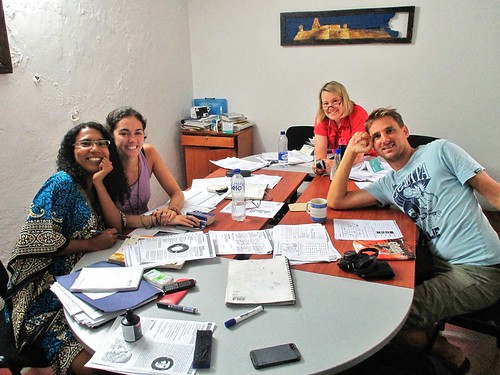After a year of travelling through South America, something about the Spanish language has become acutely clear to me. From my foreigner’s perspective, I’ve realised that it’s not enough to have a vague understanding of what people are saying, or be able to respond with a few choice phrases and bits of vocabulary.
More and more often, I’ve needed to know how to use my Spanish in much more stressful situations.
And that means arguing.
It’s not like people in South America are particularly argumentative. It’s more that I often find myself in situations where an argument is simply unavoidable.
It happens with errant taxi drivers insisting the fare costs way more than it should. It happens in restaurants when food is cold, undercooked or inedible. It happens during impromptu road blockades when you’re forced to walk for four hours, at border crossings with visa issues, and when people of all professions are being very obstinate with their small change.
The sole benefit to getting embroiled in disagreements so much of the time is that it’s been a marked improvement for my Spanish skills. With little room for pondering the right verb conjugations, I’ve been forced to think on my toes and simply say whatever I think might be right.
And there’s been a growing realisation that I can actually speak pretty damn well as a result.
So here’s my guide to arguing in Spanish. And, by extension, a guide to practicing your language skills in the most untypical of ways.
(Also, I’m using the term ‘arguing’ loosely. Basically any occasion in the last year where I’ve had to raise my voice in Spanish counts.)
1. Choose your battles
Being faced with frustrating situations is simply a way of life in South America. But while a number of these situations could develop into arguments, a lot of them simply aren’t worth the hassle.
What’s more important is to decide when it’s a good idea to make a fuss. I end up looking at each situation with the same attitude: how am I going to feel if I let things go? Much of the time, the effort of arguing – particularly when I can almost certainly predict a negative result – makes me accept preemptive defeat.
Once I’ve decided I’m going to get involved in an argument, though, my Spanish brain starts whirring. I know my arguing opponent is going to start speaking much more rapidly and probably more loudly, and I need to be ready for the switch in style.
I also need to decide pretty sharpish if I think I can win.
2. Don’t think too much
Thankfully, I’ve now passed the learning stage where I had to think of something in English and then translate it into Spanish before I spoke. However, just because there are more Spanish phrases ready to go on the tip of my tongue doesn’t necessarily mean I’m going to choose the right one.
From experience, overthinking your argument when speaking Spanish just doesn’t work. Focus too much on what words you plan to say before saying them and everything slows, to a point where you’re not really involved in the argument anymore.
On a day spent exploring Bolivia’s Torotoro Park, for example, our group of seven people paid our guide in cash before we started out for the day’s activities. Late in the afternoon, as we walked towards a three hour caving session, the guide suddenly announced that he hadn’t been paid in full. Someone had to give him the rest of the money, he said, or no caving was going to happen.
An argument immediately escalated, as soon as we fully understood what was going on – and because there was so little time to think, I was slightly amazed at the speed and variation of the Spanish tumbling out of my mouth. The other two more proficient Spanish speakers in our group spurred me on, and I formulated sentences at lightning speed – without actually thinking about it.
It was a great morale booster to discover how much Spanish I’d absorbed without realising, and I knew that if it could happen once, it could easily happen again.
3. Be tactful and polite (if at all possible)
Like any foreign language, some of the first words I learnt in Spanish were not exactly the most savoury ones… Even if you know all the requisite swear words, that doesn’t mean you have to use them. Plus it’s useful to remember that some words have more impact, depending on where you are in a country.
Then there’s the issue with using ‘usted’. As a general rule, the less Spanish a foreigner knows, the more acceptable it is for them to screw up their use of the polite ‘usted’ versus the casual ‘tu’. Sadly, I should definitely be able to differentiate when to use it by now – and yet I often choose to be more casual with the strangers I meet in South America, as calling a market stall owner ‘amigo’ is the everyday norm here.
When this switches to argument territory, however, it’s another matter, as I’ll usually forget the quintessential English rule: the more angry you are, the more polite you get.
There’s a fine line in an argument between keeping the peace and things getting heated. Using the more polite forms of Spanish verbs may just be that line.
4. Know when to get emotional and/or angry
Although I try to stay calm in an argument as much as possible, there’s still a lot of collateral to be had in a few tears or raised voices – though I think the former is only likely to work if you’re female. Timing is crucial: too early and your opponent gets flummoxed, but too late and it’s obvious you’re putting it on.
A case in point was the very stressful day I spent at Bolivia’s border with Argentina, where I spent three hours crossing out of Bolivia and back in again, in the attempt to renew my visa. Various officials told me it would work, but at the last hurdle of entering Bolivia again, the border guard told me it had all been in vain. Which is when I turned on the waterworks, pleading with him to change his mind. Only then did he look rather surprised at the emotional outburst, and decided to inform me that I could go to any major city’s immigration office and get them to renew the visa.
Tears – 1: border guard – 0.
5. Defend yourself and stand your ground
Now you’ve come this far, you’re in it for the long haul: there’s no point in backing down from the argument. But it’s crucial to remember that Spanish is a much more confrontational language than English, and this requires you to exhibit a certain level of confidence.
That confidence – as well as the dedication that accompanies it – will be the marker of how serious you are about the situation you’re embroiled in. Like how you deal with walking for four hours along a Bolivian highway towards Cochabamba, carrying an assortment of bags totalling 13 kilos under the blazing sun. In a cruel twist of fate, our night bus from Potosí had been forced to halt after it met a citywide protest that had rendered all transport useless, and the only way we could get to our hostel was by walking there.
Despite not knowing where the hostel was, or where we ourselves even were.
Luckily, I had a working phone and the number of Alex, our hostel’s manager, so I got in touch and we exchanged countless brief calls about what road we could possibly be on, the potential of Alex driving to find us, and how bad the protest situation was.
While I didn’t end up arguing in this particular instance, I was perpetually on high alert in regards to my Spanish: asking numerous fellow walkers for updates on what was happening, getting heated with Alex about how much further we had to walk before we’d reach him, and generally eavesdropping on any Spanish I heard around us.
6. Practice, practice, practice
After a year of speaking Spanish I still have a long way to go, which ultimately means my Spanish arguments are stuck at a developmental level. But while I’m in no way suggesting that you should be actively arguing with every person you encounter in South America, there’s still a lot to be said for this style of Spanish speaking – and there’s no doubt it’s improved my language skills tenfold.
I never really thought I’d get to the stage where having an argument in Spanish was even faesible, let alone an averagely common occurrence. So after a year of speaking a language I was once terrified I’d barely get to grips with, it’s now onwards and upwards on the path to fluency – although hopefully without too many fights…
Have you ever had an argument in a foreign language? Do you have any tips I might have missed? How about other untraditional methods for practicing a language?












10 Comments
Lauren
February 27, 2014 at 1:44 amWhile I don’t speak any other languages (wish I could…need to start learning!) I have never really thought about arguing in a different language! I would find it to be very difficult as other people started speaking more quickly, and you have to act more quickly, too! I would be a little bit intimidated by the other person and not feeling as comfortable, but it sounds like you can speak Spanish well enough to feel more confident! Also, I’m sure these types of “exercises” can help you learn the language even better!
Flora
March 20, 2014 at 1:30 amIt can definitely be a little terrifying when the speed picks up but you’re right, it certainly helps with building your confidence. Thinking about them as exercises would also probably make you forget you’re actually having an argument, which makes it a bit easier!
Josh
February 27, 2014 at 12:35 pmHey Flora, thanks for the ping!
Latin American Spanish is so incredibly different to Spanish Spanish. The weird thing is that I first started to speak it (or at least attempt t speak it) when travelling through South America, but that was such a long time ago that I couldn’t possibly have been able to hear the difference in accent/dialect etc. Last week I met 3 Uruguayan girls who were bloody difficult to understand, and now I’m at a level with Spanish whereby I rarely find myself struggling!
Suerte con el resto de tu cruzada española!!
Flora
March 20, 2014 at 1:31 amYou’re welcome Josh! Yep, I’m still slightly terrified about how much my spanish will crumble once I try speaking it in Spain – but for now I like to think I’m doing alright 🙂
Rob
February 27, 2014 at 8:26 pmAnother great post, I hope it gives some inspiration for people to travel to South America to study Spanish. I’ve shared the article on our facebook page.
Thanks
Rob
Flora
March 20, 2014 at 12:52 amI hope so too Rob! Thanks for sharing 🙂
Andrew
March 2, 2015 at 3:48 amBe Careful About Saying ‘I’M FLUENT’.
>
I’m American, born and raised in the English language. I lived and studied Spanish for a few of my 6 years in Mexico. When I speak Spanish here in America in front of my ‘gringo’ friends they say how well I speak it and how wonderful it must be to be ‘Fluent’
>
Fluent . . Not a Chance. . Take my test to see how well you speak Spanish?
>
Go with 5 or 6 native friends to a local, cantina with live loud music and lots of people there talking away so you have to speak above the noise to be heard(and of course, straining a little hear what everyone are saying). Now order some drinks and soon EVERYONE at the table will be talking loudly, ALL 6 FRIENDS AT ONCE to each other and the table at large, speaking in idioms and talking Ha-Ha- Funny and making jokes all At The Same Time.
>
If you can keep up and be part of it all..Hats off to you…You Are Fluent!!
Andrew
March 2, 2015 at 4:15 amPS If you didn’t pass the above ‘Fluency Test’ ( I never passed that test while living there), here is a lower level self exam, kind of like your ‘argument’
>
If you can make a funny, off-the-cuff remark within a conversation or suddenly tell a quick, whimsical story that apropos to the situation at hand, you’re well on your way to speaking the language. . .
>
Best of Luck
Tell-tale signs that you’re becoming fluent in another language | Spain For Pleasure
March 11, 2015 at 4:36 pm[…] it’s just great to let rip without really caring if you’re making mistakes, as Flora The Explorer knows only too well. That’s when you know you’re getting good at […]
Sam
October 22, 2017 at 5:07 amLast year, I finished my second year of Spanish. My friend, Eleanor, finished her third. And one thing I realized at the beginning of this school year was that even though she has much more knowledge than me, (as she explained it to me: Spanish 2– “I know stuff!” Spanish 3–“I thought I knew stuff”), having learned el subjuntivo, el futuro and how to say some things that I still don’t know… I simply know (conocer) much more than she knows (saber).
By that, I mean that all of her experience speaking Spanish has been in a classroom, in predetermined conversations with set dialogues and structures, and I’ve had to ask a little girl in Havana how to find the marque, and her get increasingly confused until I asked again, only this time using mercado. I’ve discovered that to a 15 year old Argentinian girl, “colegio” means college, not “secondary school” as it does in other places like Ecuador, and that translating “ice” into spanish and “hielo” to English is a mess no matter how you slice it.
So while I’ve never argued with someone in Spanish, I have certainly tried desperately to teach my mother how to say “jugo de naranja” and not “ju-GOO what was it again?”, and asked the cleaning lady at our hotel room in Mexico to “please come back at 2pm, my sister is in the shower” and helped our taxi driver in Havana explain to my dad that the car in front of us was a Russian (Soviet) model.
All in all, thanks for sharing about arguing in Spanish. I’ll have to practice it.